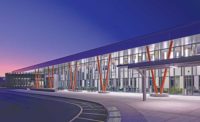 Although four high cranes crowned construction of Taiwans Taipai 101 tower, an unglamorous set of rack-and-pinion hoists are the jobs access workhorses. Clinging to the outside of one of the buildings facades, the worlds tallest-ever hoist tower of its type continues serving contractors now that the heavy lifting is over.
Although four high cranes crowned construction of Taiwans Taipai 101 tower, an unglamorous set of rack-and-pinion hoists are the jobs access workhorses. Clinging to the outside of one of the buildings facades, the worlds tallest-ever hoist tower of its type continues serving contractors now that the heavy lifting is over.
In countless creaky trips, six hoists have made virtually all deliveries of people, equipment and materials, except structural steelwork, to their work places. With sizes tailored even for curtain wall panels, the hoists were an efficient though unusual tool for facade subcontractor Josef Gartner & Co. (HK) Ltd., says General Manager Stuart Orr.
|
The jerky and noisy technology driving the hoists has been around a long time, but the Swedish-based supplier still sees growth for rack-and-pinion systems. With no immediate plans for a technological shift, Intervect A.B., Uppsala, aims to grow substantially by nibbling at the hugely dominant scaffold market.
Equivalent to under 5% of the global scaffolding business, rack-and-pinion access stands to gain $100 million a year for every 1% of the market it captures, says Intervect President and CEO Petter Arvidson. Making that grab in three years to boost annual sales of nearly $150 million now "is not unrealistic," he adds.
Intervect was created by private investors three years ago to acquire the newly merged Alimak B.V., Sweden, and Netherlands-based HEK International Group B.V. Now, HEK concentrates more on construction, selling and renting work and transportation platforms plus lightweight materials hoists. Alimak deals in construction hoists, along with industrial, mining and dockside equipment. All have motors powering rack-and-pinion drives up supporting masts that are attached to the main structure and need no foundation.
 |
| GOING UP Hoist climbs world's tallest. |
Intervect claims to be the only global player in its business. It forecasts growth of 3% a year to 2006, largely through increased sales in Eastern Europe and Asia. Europe accounts for half of Intervects sales. The U.S. and Asia/Australia each contribute just under 25%.
Intervect makes its own equipment, all in Europe, and sees its future increasingly as a service providerdesigning, installing and operating access systems for contractors, says Ernst van Hek, HEKs president. About 60% of revenue already is from contractors, says Arvidson.
In the U.S., the firm is fighting lack of familiarity. Rack-and-pinionwork platforms remain an exotic option to scaffolding, says Dale Stoddard, president of Intervect U.S.A. Inc., Bridgeport, Conn.
Obtaining affordable financing is the key to growth, Stoddard says. "What we sorely need here...is understanding by financial groups of the value of the product," he adds. Stoddards strategy is to create a network of independent regional fleet owners. "The U.S. market is not conducive to having a single-source rental outfitits too big," he says.
In selling the concept in the U.S., "we talk to the contractors about the reduction of their liability...in terms of worker safety," says Stoddard. In Europe, access equipment is centrally regulated. In the U.S., most rules and regulations are driven locally and by liability exposure. "We have almost as many attorneys as we do customers," he jokes.


Post a comment to this article
Report Abusive Comment